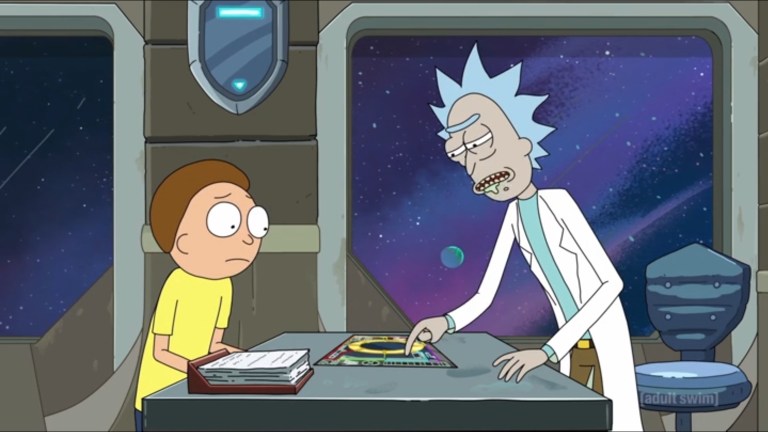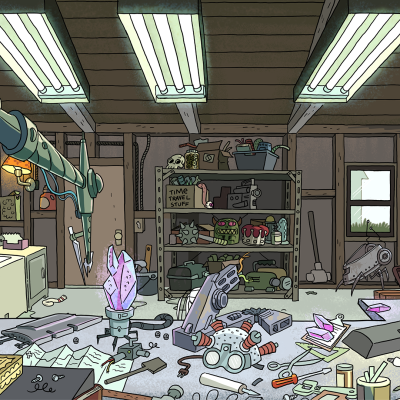How Rick and Morty Season 4 Debuts Dan Harmon’s Story Circle
The newest episode of Rick and Morty showcases Dan Harmon’s story circle and explains why his creations keep eating themselves.

This article contains spoilers for Rick and Morty Season 4 Episode 6.
To be fair, you have to have a very high IQ to understand the most recent episode of Rick and Morty and apparently I’m dumb as hell because it looks like critics (even on this very website!) have by and large enjoyed “Never Ricking Morty,” while I found it tiresome and confusing.
I did understand it, broadly. Though it isn’t explained until almost the end of the episode that there’s a dude called the Story Lord behind it all, Rick and Morty are on a story train that forces cutaways to vignettes. It’s technically this season’s Interdimensional Cable episode, but with a very different, and much harder to follow, framework. (Going forward, I intend to criticize all meta narratives by paraphrasing Rick: “It’s like ‘Never Ricking Morty,’ Morty, so, if it’s confusing and stupid, then so is everybody’s favorite episode.”)
More than that, it’s a story about Dan Harmon’s story circle. For those unaware, since all the way back when he was making 5-minute internet comedy sketches on Channel101.com, Harmon has structured his plots using a story circle template based on the monomyth aka the hero’s journey, which he adapted from Joseph Campbell’s The Hero with a Thousand Faces. Harmon’s story circle goes clockwise through eight stages: 1. A character is in a zone of comfort, 2. But they want something, 3. They enter an unfamiliar situation, 4. Adapt to it, 5. Get what they wanted, 6. Pay a heavy price for it, and 7. Return to their familiar situation, 8. Having changed. I took this directly from an old blog post by Harmon where he goes into more detail, if you’re interested. In “Never Ricking Morty,” Rick actually pulls out a visual representation of the story circle and references some of the language from it (he mentions “paying a heavy price” and a “threshold,” which is a reference to the third stage, which Harmon alternatively calls “crossing the threshold”).
His career neatly conforming to the repeating cycle of his story circle, Harmon has been here before. In the first half of Community’s season five finale, the character of Abed starts openly referencing the stages of the story circle, too. Hell, you can go back to one of Harmon’s old comedy shorts from 2006, “The Lynx,” in which the name of each stage of the circle is superimposed onscreen as it’s happening (fair warning: it’s a pretty gross short and you see a surprising amount of Mr. Harmon’s naked body). There’s a clear pattern here, where Harmon takes a character that was already a Harmon self-insert (it’s been said before Justin Roiland is just doing a Harmon impression when he does Rick; Harmon saw the characters of Abed and Jeff in Community as his two halves; and, in “The Lynx,” the protagonist is, well, literally him) and then that character becomes hyper-self-aware of the structure surrounding them and their role within it.
It only makes sense that everything Dan Harmon does eventually goes in this direction. He’s obsessed with narrative structure, sitcom tropes, and himself (hey, he wouldn’t deny it; his wedding featured dancers wearing giant Harmon-head cardboard cutouts). Plus, with Rick, it was a hardly a leap to reach this point. Dude is already a nearly all-knowing master of the universe who sometimes openly declares the fact that he’s in a TV show (though the latter might be something that comes more from the Justin Roiland side; characters do the same thing in his new, Harmon-less show, Solar Opposites).
However, I don’t know how much fun it is to actually watch. It feels like the story gets lost wayyy up inside its own butthole, Morty, and at that point you’re just watching the gears of the plot turning, which makes it harder to appreciate the jokes wherever they manage to be squeezed in. Harmon made a lot of amazing, hilarious shit on Channel 101 (I recommend checking out “Laser Fart” and “Water and Power”), but “The Lynx” is definitely a lesser work. I found “Never Ricking Morty” pretty bewildering and it’s my belief the season five finale of Community is the worst thing he’s ever produced. Obviously, there are good stories about stories, like Harmon hero Charlie Kaufman’s Adaptation. Plus, arguably all of Harmon’s work is like this, on some level, but when he really gets down into the weeds of the process, I just find it alienating and boring.
I might call these shark-jumping moments, but many a Community shark was already jumped in season four, the season Harmon was fired for so that’s everyone’s fault but his, and, in the sixth and final season, he still pulled out a classic finale and ended on a moving and meta note. As for Rick and Morty, this series has so blown apart its own multiverse so many times you could argue it jumped the shark just by bothering to go on after the first season. It’s already saddled with the continuous problem of a main character who’s basically God struggling to create conflict for himself in a universe he can vacate any time he feels like it to shack up in another.
“Never Ricking Morty” has a scene where the Story Lord uses a machine to suck the story potential out of Rick and Morty. Rick says, “You idiot, our potential isn’t limitless.” We’re then treated to a number of potential future scenes from the series, including a finale, which, sure, why not? Obviously, it’s not in any way a reflection of how the show will actually end; they still have 60(!) episodes to go and have no clue what track they’re gonna put this runaway story train on. But it’s telling that they’re already exploring the very notion of the limits of their own story potential and how everything could end.
Dan Harmon’s ambition and deep understanding of story (especially sitcom) structure is a double-edged sword. It’s because he understands this stuff and is so good at it that he can create brilliant television that lampshades and analyzes tropes while simultaneously using them to create engaging, funny, and affecting television. But when a show’s creator and, by extension, the show, is this self-aware, it inevitably begins eating itself. After dissecting its characters and its universe (something Rick and Morty all but blew through swiftly and brilliantly in its first, and still best, season), where else can it turn its deconstructive gaze on but its own narrative structure?
Maybe “Never Ricking Morty” is just one uber-meta story in what’ll turn out to be Rick and Morty forever, a hundred years Rick and Morty, of, to quote Rick, “nicely grounded, fully immersive from here on out” episodes. But I feel it’s a revealing episode, one that shows that the Dan Harmon show-writing approach is exciting, brilliant, and ultimately destructive. It was cool to watch them get here, but the characters now know too much about themselves, their universe, and even the medium through which their stories are told. With all that in mind, it makes sense they’d be doing stories about stories, but being clever, and self-referential doesn’t necessarily make for a fun watch. And where do we go from here?
I know others found this super-self-aware episode cool, but when Rick whipped out that familiar story ouroboros, my eyes glazed over. “I don’t like how meta this is getting, Rick,” says Morty. Hey, you and me both, my dude.
